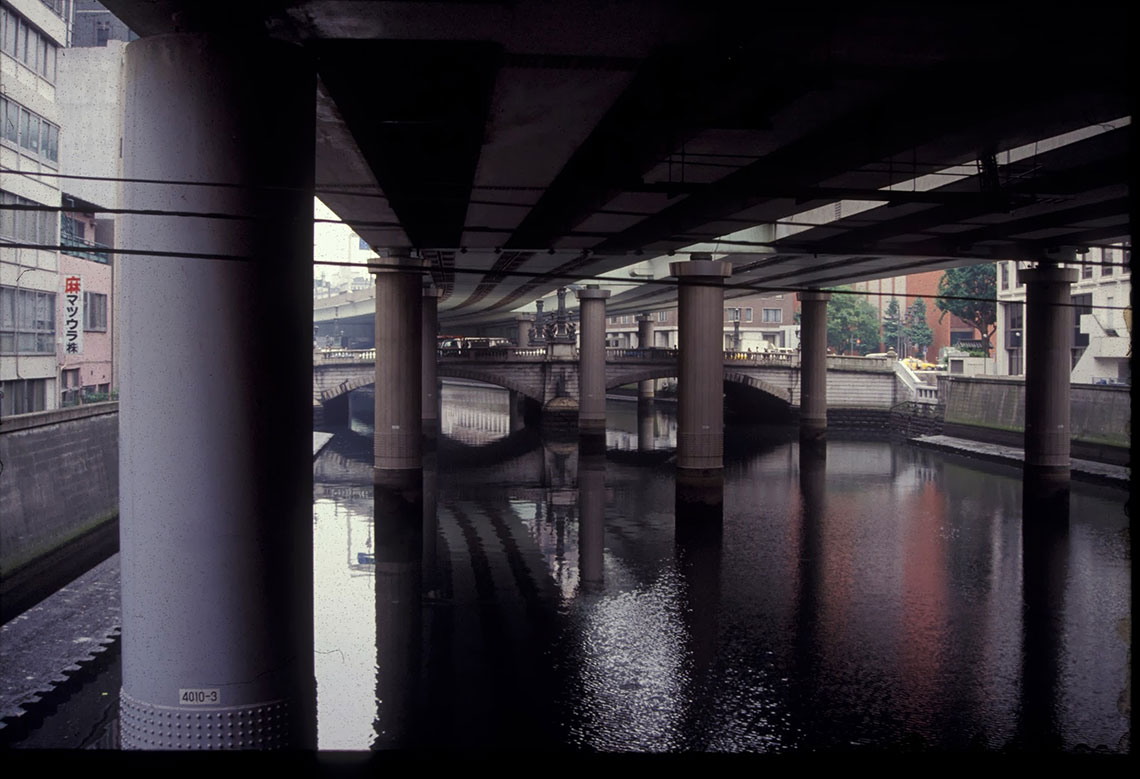The route from Kanda to Nihonbashi skirts the very centers of new Tokyo and old Edo which lie next to each other. Modern Tokyo is big business, and the Nakasendo passes through some of the main business areas of the present city, but most of the corporate headquarters lie to the west of the highway, a few city blocks away. Likewise, the center of plebeian Edo is penetrated, but even though the traveler ends up on the ‘Bridge of Japan’ (Nihonbashi), much of the city of the merchants and artisans lies a few blocks to the east. It is almost a no man’s land: neither samurai nor merchant, neither big business nor the old city of the Edokko (‘Children of Edo’) dominates the area.
Within a few blocks of Kanda are the headquarters of the main book publishers as well as the center of the used book trade. After passing under the elevated train tracks of the Chuo line (running due west into the best suburbs) and the Sobu line (connecting those suburbs, the city center, and the booming prefecture of Chiba which is rapidly changing from a rural to a massively urban area), if a left is taken at the next large road, one runs into the Jimbocho used book district with at least a hundred new and used book dealers. Look the other way and there is Akihabara, center for electronic goods retailing. Before that are the spires of Nikolai Cathedral, the Russian Orthodox church which was under repair in 1992-3, but survived the firestorms of the Great Kanto Earthquake of 1923, sheltering hundreds of victims made homeless. Beyond it are a number of major private universities.
A few blocks further on and the Nakasendo passes under more elevated train tracks. This is the main commuter and trunk line running from Yokohama to Tokyo (just one station south of Kanda) and north up to the northern suburbs and the eastern sea coast. Kanda Station is here and close by is the main International Post Office. Long distance travel has a long tradition here; in the Edo period , two hundred yards to the east the traveler would find the central staging area for horses used on the Nakasendo and the other four highways.
There are a mere one thousand yards left to the Nakasendo now. The last steps bring the traveler into the center of Edo’s merchant area, but it has long since lost that character. Once a financial center for young Japan in the late 19th and early 20th centuries, there are still some large banks, but their headquarters too have moved and are a half mile west and south. One that stayed, to the west of the highway, is the Bank of Japan which is the central bank. On the left is where the Dutch merchants always stayed when they made their trips to Edo as was required by the system of alternate residence.
Retail commerce is still important, as it was in the Edo period. The old Echigoya dry goods shop established in the 17th century is now eight stories tall and is a highly successful department store, renamed Mitsukoshi. Mitsukoshi’s main foyer is extravagantly decorated and among the hundreds of food counters in the basement is the Imperial Hotel bakery which offers some of the best, fresh-baked bread anywhere. Beyond the department store, there remain no more than 50 steps to the Nakasendo.
Ahead is Nihonbashi, the ‘Bridge of Japan’, in the middle of which is the marker from which mileage throughout Japan is measured. The lamps on the bridge are ornate, but they get swallowed up by the elevated highway that passes directly overhead.
To the east of this last half mile lies blocks and blocks of shops and shop-houses which still have a flavor distinct from modern, corporate Japan. The Edo period stores and dwellings were all destroyed in the 1923 tremor, but the area still calls to mind how crowded this area was. In the early 1700s, reasonable estimates showed a population concentration in Kanda and Nihonbashi of nearly 70,000 people per square mile compared with a mere 15,000 per mile in the samurai districts and 22,000 odd people in the most crowded districts today. Little wonder that a fire in 1657 had killed over 100,000 people. Just ahead was one of Edo’s many fish markets, now mercifully removed together with its smell. In the Edo period, Miura Anjin, or Williams Adams as he was known in his native England, lived just ahead too. He came as pilot on a Dutch ship and never left (he was the model for Jim Blackthorne in James Calvell’s novel Shogun and the movie based on it).


